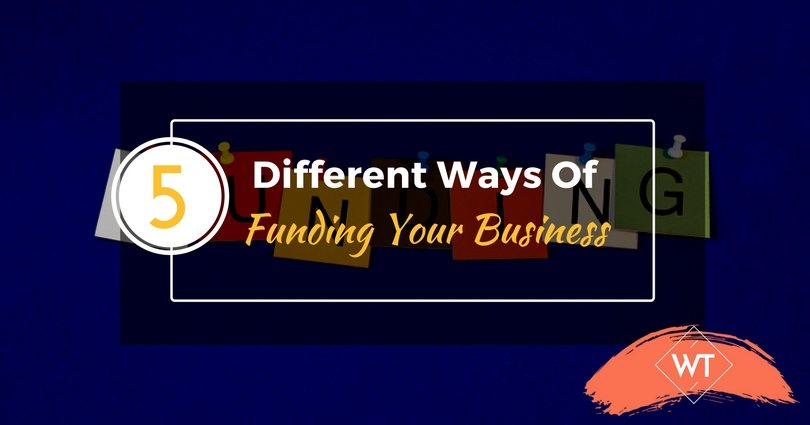5 Different Ways of Funding Your Business

As an online business coach who has built a brand from scratch, I often get asked by clients and readers about funding for their business. More specifically,
- How are they supposed to get the money to start their venture?
- Do they need investors?
- Should they get a loan?
- Is Crowdfunding an option?
- Raise money from friends and family?
The problem I keep running into is there’s a lot of misinformation out there about the different ways of funding your business. Many people assume they need investors when that may not be true at all.
After all, it’s a false belief many people grow up with: In order to build a business you first need a lot of money .
The truth is, the kind of funding method you choose completely depends on your relationship to money, what kind of business you are building and your timeline. Some ventures also need more money than others.
Below you’ll find the different methods of funding your business, their pros and their cons. By taking all of these things into consideration you’ll be able to better make a decision for yourself.
1. Bootstrap
Bootstrapping refers to using your own money to build your company. That means no outside investors. This is a situation where the entrepreneur starts their company with little capital and you either put our own money into it or use the company revenue to cover operating costs.
Pros
There are two main pros here.
- First, there’s no need to go through the process of pitching investors or applying for grants.
- Second, you keep full control and make all the decisions of where the company can go.
Truth be told this is also the quickest way to get started.
I will tell you from my own personal experience that I’ve bootstrapped my entire business. Everything has been built with my own money or the money that came from the business. I also don’t really have an interest in investors so that I can have complete control over where my brand goes and how it serves people. However, that’s just me and my business doesn’t have high operating costs.
Cons
Of course, with pros come cons. The main con here is that you may not be able to grow as fast . . . because funds are limited. This is why, the kind of business you are in and what your timeline is are so important to determine which route you will go.
However, it’s also important to note that slow growth doesn’t mean you can’t reach your goals.
Entrepreneurial powerhouses like Marie Forleo and Danielle LaPorte have both bootstrapped seven figure businesses.
What about using credit cards for funding your business? It’s an option, yes. There are personal credit cards, and there are cards tailored toward small businesses. Be careful with these, however, as you will wreck your personal finances if the bills aren’t paid. This falls more into the category of Debt Funding, however . . . and we’ll come to that in a minute.
2. Venture Capital
Venture capital, sometimes also referred to as equity capital, refers to money that was provided by investors to startup firms or small businesses with perceived long-term growth. This method requires getting very clear on company projections and pitching to investors in the hopes that they will give you money.
Pros
You get a lot of money from a pool of either a group of wealthy investors, investment banks or other financial institutions. It’s a popular form of funding among new companies with limited operating history and who can’t use debt funding (more on that later).
Cons
The investors have a major say in business decisions and a portion of the equity. In other words, you don’t totally own your company anymore. For some, including myself, this is enough of a con to avoid this route. But again, this depends on what kind of a business you are in and how much money you actually need.
If you need $1 million in capital to get your business off the ground, then venture capital may be your desired route.
3. Debt Capital
Many people also go the route of getting a small business loan from a financial institution in order to fund their venture. This can be good if you are clear on how the money will be invested and how you’ll see the return on the investment. In fact, the issuing bank will require that you prove how the money will be paid back before they even think about giving you a loan. Whether or not you get the loan will also depend on other factors such as your credit history.
A small business loan certainly has some advantages over both bootstrapping and venture capital. Namely, you get the money you need, and while the bank has access to quarterly financial statements, they don’t own equity and can’t really tell you what to do with your business.
On a more personal level, whether or not you go this route will depend on your relationship to debt. For some, they’d rather avoid debt at all costs and are very risk averse. Others don’t really mind the risk. For a solid breakdown of the advantages and disadvantages of venture capital versus debt capital, check out this article on Forbes.
The bottom line is you need clarity about your business goals. You also need to crunch some numbers. By having this information you’ll know exactly which route is right for you.
4. Crowdfunding
The most common type of crowdfunding fundraising is using sites like the Kickstarter and Indiegogo variety, where donations are sought in return for special rewards.
One notable and incredibly successful crowdfunding effort was when 90’s R&B group TLC asked their fans to fund their next independent album. Some of the rewards included a handwritten letter from the members of the group, a shopping day with one of the members, a list of their favorite songs and so on. The campaign was so successful they raised the money they needed in less than 48 hours.
You don’t have to be a famous girl group with a fan base to use Kickstarter though. Many entrepreneurial ventures by non-famous people got their start thanks to this crowdfunding platform.
For a solid walkthrough of how to successfully use crowdfunding to start your business check out this piece on OPEN Forum.
5. Raise money from friends and family
One last option you could use is to raise money from friends and family. Of course, mixing family, friends and money can be tricky so you’ll want to keep a couple of things in mind:
- Are there any strings attached to this money?
- What are the clear guidelines for this money? Is it a loan? Will there be interest? What are the terms?
- Do your friends and family get anything in return for the investment?
Make sure everyone is on the same page to avoid any issues later on.
Options to align with your values before funding your business
Lastly, before you select an option for funding your business, you’ll want to check in to see which option aligns with your values. Like I previously mentioned,
- I don’t want investors because it’s not in alignment with my value of keeping control of my company.
- I’m also very risk averse and not a fan of debt.
Everyone is different in this regard so you must get clear on what your own value system is in regard to money and business.









Leave a Reply